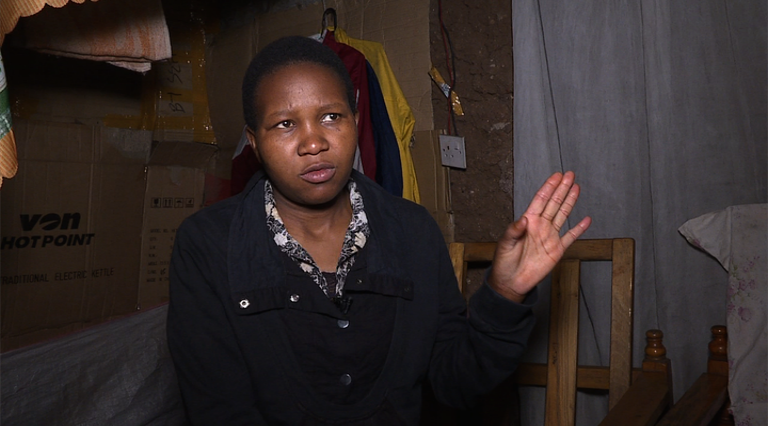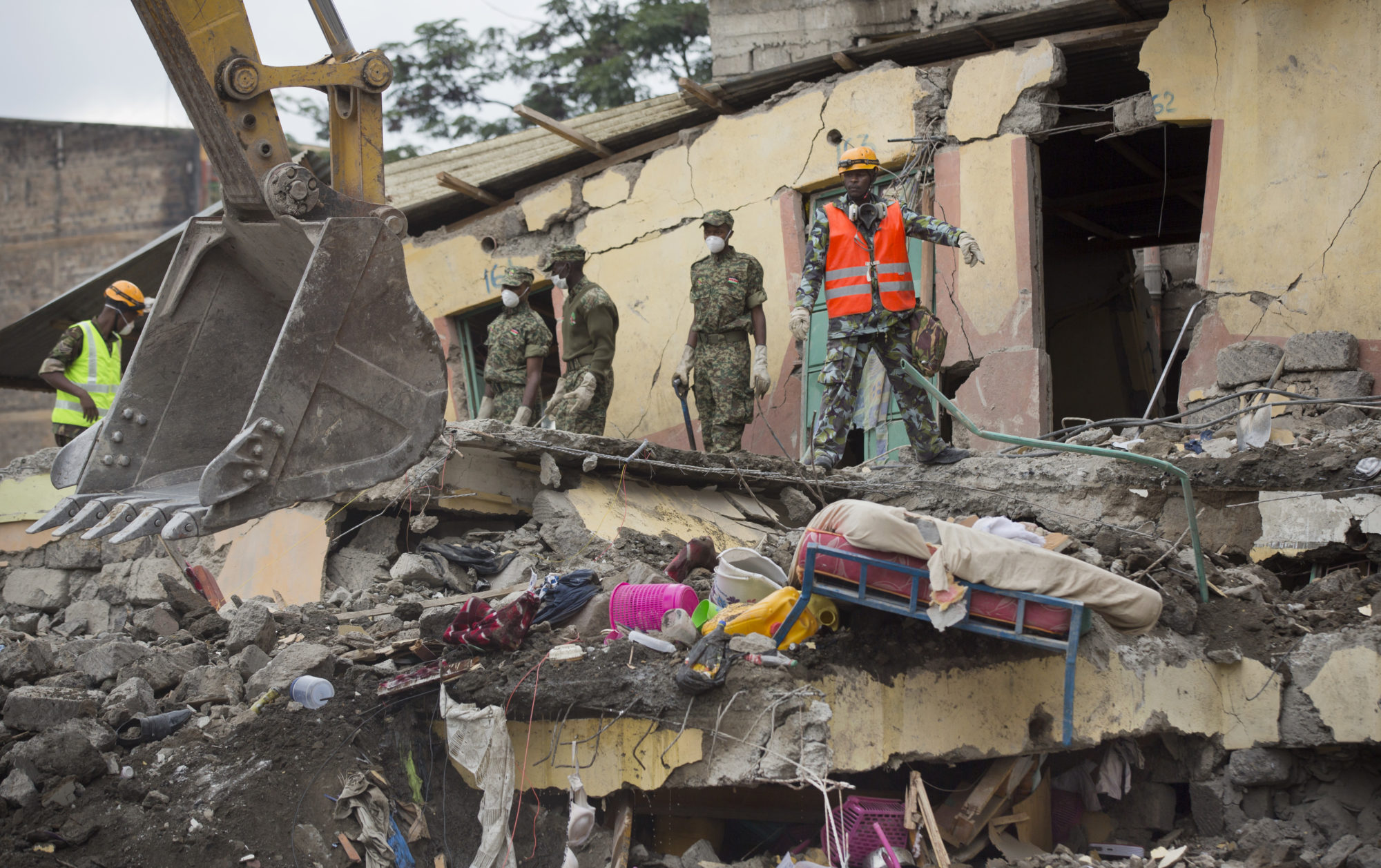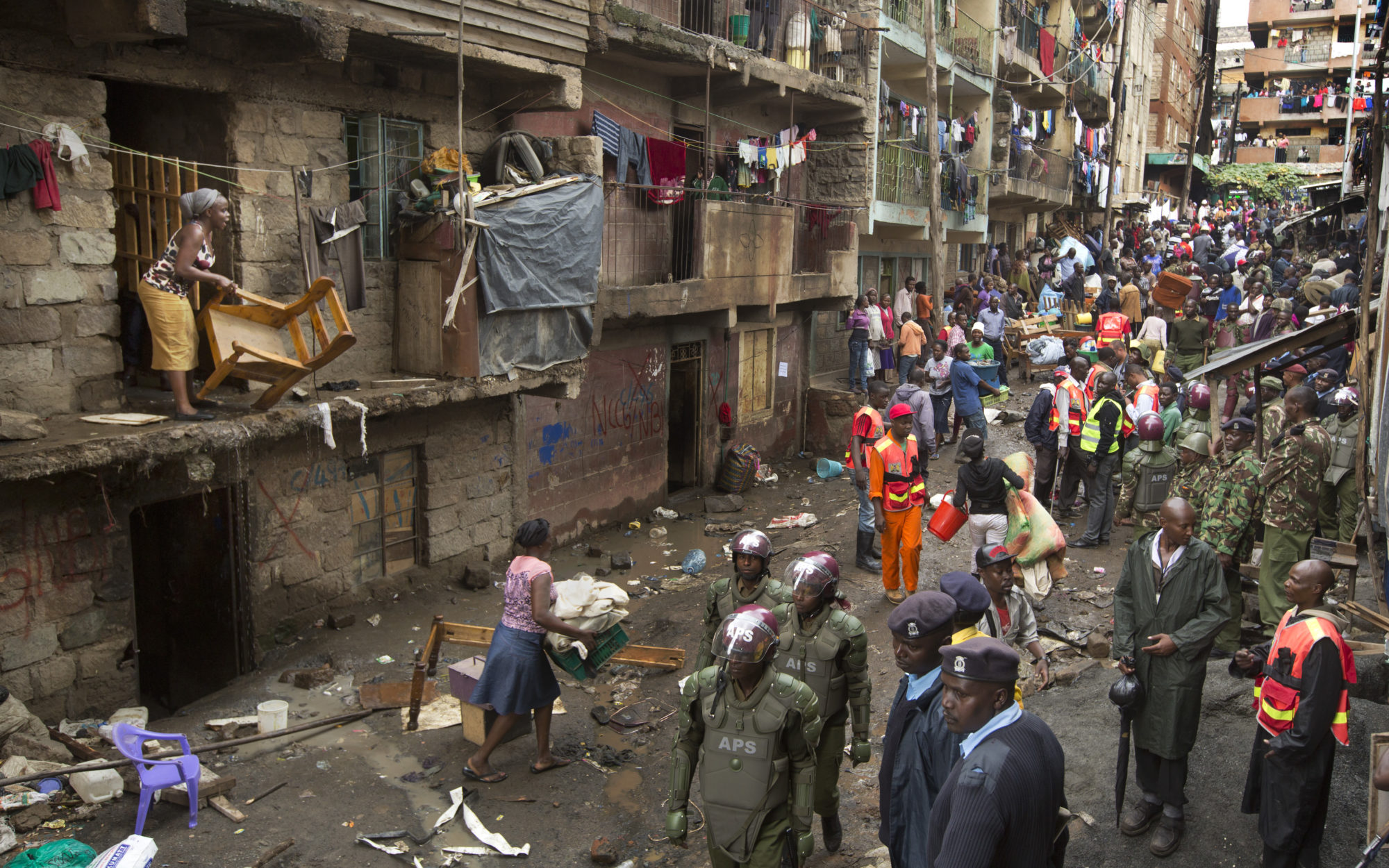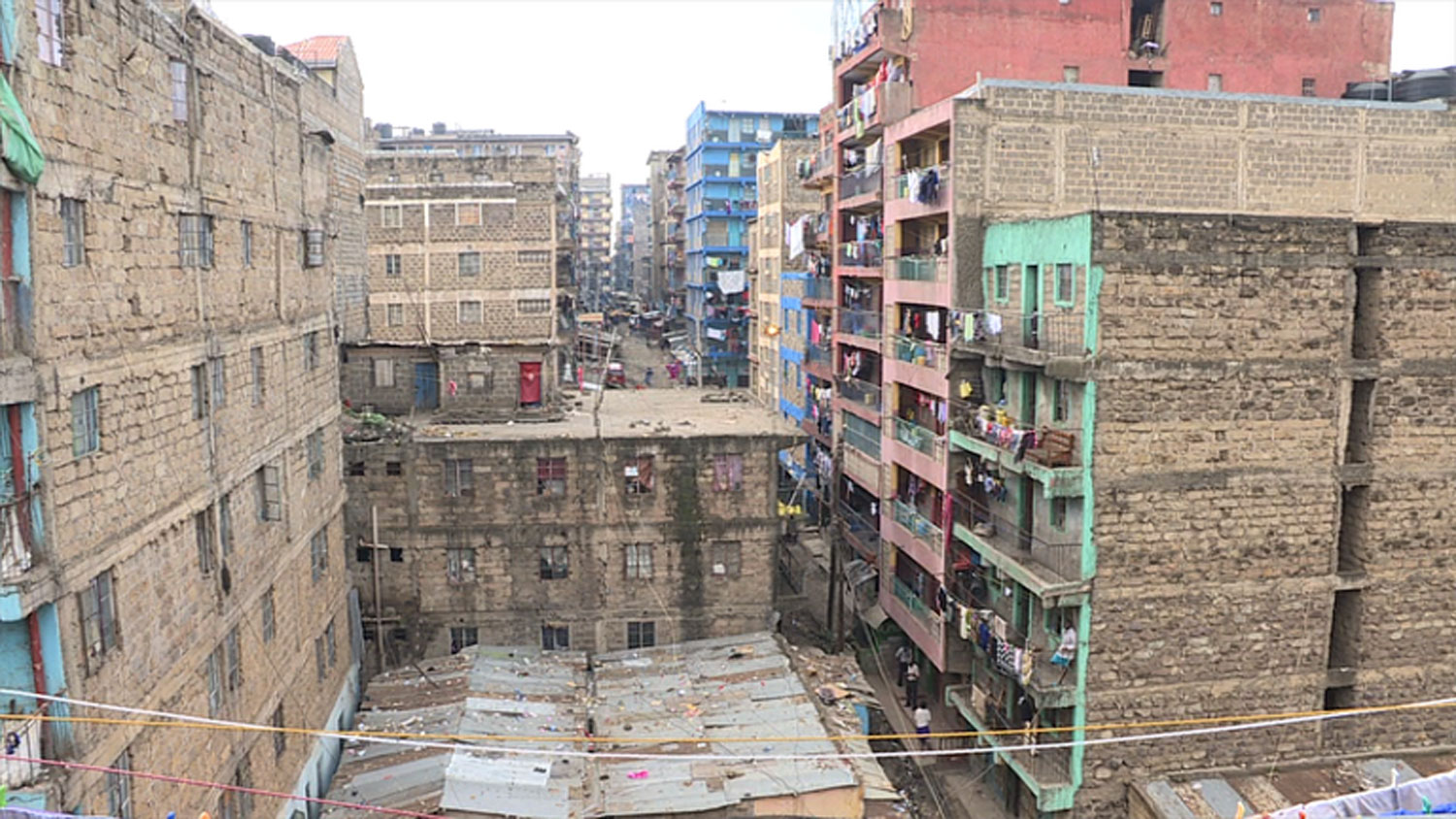Sixteen months ago, Agnes Kavere became a survivor.
At the end of April 2016, she was in her house in Huruma, Nairobi, Kenya’s capital and biggest city. She had just arrived from a rural farm to visit her husband, who had been living in the city.
She remembers the day clearly: It was raining heavily, and then the six-story tower collapsed around her. Fifty-two of her neighbors died that day. Since then Kavere and her three children have lived scarred lives.
“People had said the building was going to fall,” said Kavere, who now lives with a friend in a one-room shack in the Kibera slum’s Mashimoni neighborhood. “The day before the building collapsed, the windows cracked and broke. But my husband told me that we should persevere. That the following day we would move out. So we stayed, but we could not even sleep, because we did not know what was going to happen.”
“My husband told me that we should persevere. That the following day we would move out. So we stayed, but we could not even sleep.”
On the day of the collapse, Kavere was making dinner when the structure began to shake.
“My husband was on the third floor and I called him to come down and listen to the tremors,” she recalled. “He told me to stop cooking, pick the child, and help move our property upstairs. He said ‘upstairs,’ but I hesitated. How could upstairs be safe? … I did not want to argue, so I put the child on my back and we started ferrying our things to the third floor.”
It took a while, and the couple managed a few trips up and down the stairs, moving their belongings, before the building finally yielded to the weight of its shoddy construction. Kavere was glad she carried her child on her back the whole time. The two were found and pulled from the rubble. Days later, recovering in the hospital, she was told her husband, Moses Khayumba, had died. They found his body at the City Mortuary, along with other bodies of adults and children.

Kavere and her husband had occupied their one-room flat for two years. She recalls that there had never been a sign that it would come tumbling down. Not even the suspicious closeness to a river dissuaded them from living in the building. It was affordable and they thought it solid, and didn’t know that its closeness to a river violated regulations of the National environment management authority.
A History of Failure
Around the globe building codes of modern governments are failing, undermined by corruption, lax regulation and the forces of nature.
Improper construction has brought down massive structures, dating back to ancient civilizations in Greece and Rome. The failure of dams, globally, has claimed more lives than any other construction category. And buildings have fallen because of mistakes and poor regulation in first-world cities as well, from London to Alexandria, Virginia in the United States.
But it is in modern skyscrapers where people live and work, and must place faith in architects, builders and government regulators. Too often, slip-shod work, poor standards and regulation – and corruption – have let people down. The world’s worst collapse in recent history was the Savar Building at Rana Plaza in Dhaka, Bangladesh. At least 1,100 people died, and another 2,500 were injured – most of them workers in garment factories crammed into a building that had been built four stories higher than its authorized design. The Savar collapse was a textbook example of how poor planning, construction and government oversight create an avoidable disaster: The building was constructed on a drained lake, the intended use was changed to industrial midway through construction, and poor materials and the unauthorized floors all combined to doom the garment workers.
But it doesn’t have to be like this.
In Africa’s burgeoning cities, ignorance of building codes is not a given. Just across the border, in Uganda, government and industry appear to have learned their lessons and come together to change how things are built, after several tragic collapses a few years ago.
Change, however, is slow to come in Nigeria, where breakneck population growth has aggravated chronic disregard for building codes and construction standards. Punishment has been rare in a country where several collapses in recent decades have claimed dozens of victims.
Across the Atlantic Ocean, builders and regulators around the globe are now monitoring how the government in Mexico City responds to the worst case scenario – the terrible consequences of corruption and lax regulation in urban construction: An earthquake this fall claimed almost 400 lives and felled dozens of buildings. Residents and civic activists blame off-code construction — and official corruption — for allowing some of those buildings to go up in the first place.
But it is in Kenya where the problem of lax coding and shoddy construction has become acute. There, no single, significant natural disaster brought down apartment and commercial towers. Rather, it is as if some structures, put up in a hurry to chase profits, are built to fail.
In Nairobi, buildings in poor neighborhoods have collapsed in surprising numbers because builders have cut corners, regulators have not held builders to standards, and government building codes are poorly enforced by a dizzying number of local and federal agencies. The first building to fall with notable fatalities was the Sunbeam Supermarket in May 1996. Sixteen people died when the store’s roof came down on them.
To avoid further tragedies, the government pledged swift action. It appointed a task force to investigate causes of the collapse, and to map out changes to national and local building rules.
The team travelled to Malaysia, Hong Kong and Singapore in search of best building practices. It determined that what had led to the Sunbeam collapse was a simple lack of maintenance. The Nairobi city council was also faulted for not conducting proper inspections. And the market’s owners were accused of changing the use of the building without a permit.
Two decades later, however, not much has changed. Construction of substandard structures goes on.
In Kenya, several key players dominate the construction industry, governed by a dizzying array of different regulatory bodies.
There are the architects, governed by the Architectural Association of Kenya. Engineers are governed by the Engineers Board of Kenya. They pick up from the architects and design how the building should be placed on the ground with all the services.
Then there is National Environment Management Authority (NEMA), which ensures that the building and the construction process do not harm the surrounding neighborhood and environment. Local and county officials must approve the drawings and construction, and then ensure the project adhered to plan. And don’t forget the contractors who realize the vision of architects and engineers. Contractors work under supervision of the National Construction Authority (NCA), which regulates buildings under construction.
And then, once buildings are up and occupied, officials from the National Buildings Inspectorate step in.
Construction industry analyst said problems in the construction sector in Kenya can be traced the multiple layers of regulators.
“A chain is only as good as the links,” said Daniel Manduku, chief executive of the National Construction Authority. “If there is any problem within the chain, there can be corruption.” Manduku said he believes that approvals ought to be done under one umbrella agency. Today, “some of the people who are supposed to approve the drawings don’t have the knowledge.”

Enough Blame To Go Around
Engineers and architects said buildings collapse because unscrupulous developers are not using professionals in the chain of construction. Others said regulators in the chain don’t have resources to enforce regulations in their mandate.
The NCA cites an example of this: In October, a four-story building under construction in Kisii town, in Western Kenya, collapsed, killing eight people. The NCA said its rules were ignored, and that it lacks full authority to enforce codes.
“The worst flouting of rules is where you have been approved to have a few floors but you” keep building up beyond the written plan, Manduku said. “We had gone to Kisii, notified the police that they should not allow construction to go on there, even recorded in the occurrence book at the police station. But still it went on. Construction is a science. A building meant for three floors can’t have five.”
There are other problems: Many buildings do not have proper emergency exits, or enough entrance and exit doors for the number of residents. Buildings with more than five floors should have elevators, but often don’t.
Regulators, overwhelmed with work, are quick to blame developers for poor concrete mixtures and weak support frames that buckle under the weight of irregular buildings. In Nairobi County, every month nearly four hundred construction projects are approved, and must get a sign-off by a handful of inspectors.
“If you talk of approved plans over two years, that’s 8,000 construction plans, against 15 qualified staffers,” said Justus Kathenge, Nairobi County’s director of urban planning and compliance. “Even if one officer was to inspect two hundred sites, it would be difficult.”
Inspectors are also often threatened and assaulted by construction crews, Kathenge said.

Unstoppable Construction
Kathenge said all that – the risks and the lack of resources – allowed the Huruma building to stay open. “I looked at Huruma and said, ‘who would I send to inspect/stop the construction…it is such as risky place?’ Asked whether the county government had thought of outsourcing the inspection duties, Kathenge is reluctant to do that. ‘Compliance is a coercive process, and not many players would like to be involved.”
Kenyan officials admit that most inspections don’t take place until after construction is complete and there are complaints. By then, many buildings have been found to be uninhabitable.
After the Huruma tragedy, the national government embarked on a project to inspect and demolish substandard buildings. Government-sponsored demolitions started, but soon stopped, partly because of court challenges by owners. Some claimed that it was the government had allowed them to build in the first place, and that stopping construction has threatened their investments. Also, the government realized that demolitions are expensive and can be dangerous.
Moreover, tenants complain that they’ll have nowhere else to go.
With all this laid out before them, regulators pause.
“We don’t want to be seen as a demolition squad destroying people’s investments,” Kathenge said.

The Body Count
Since the roof of the sunbeam supermarket collapsed in 1996, more than 170 people have died in collapsed buildings. The Huruma tragedy remains the worst. Of the 52 who died, four were children, 13 were juveniles and 34 adults.
Yet after all the deaths, there have been no convictions. No developer, no architect, no engineer or agent who put a stamp of approval on behalf of a local government has faced punishment.
Data from Kenya’s public prosecution office shows only six cases related to substandard construction pending in court, involving 17 people. Six are developers; three are contractors and three are county employees; two are engineers, and the list includes one NEMA employee, a county officer, and one architect. One of the cases has been in court for four years. It involves the collapse of a building in 2011 in Embakasi, in which four people died. Two defendants – the building owner and lead builder, are charged with manslaughter. In four years, only four witnesses have been called to testify.
While that trial has dragged on, at least a dozen more buildings have collapsed and more than one hundred people have died. Just this year, another building collapsed in the same area, killing two people.
Despite all this, it has been difficult to change laws to make enforcement and prosecution easier. Right now, the most an inspector can do to a substandard building is put a mark on it and notify the police.
“We need a law that coordinates all the others. We need one agency that can punish anyone in the chain. Even those who flout the rules, know the rules,” said Manduku.
With confusion in regulations and impunity, officials fear that collapses, deaths and injuries will continue. A growing population means there is need for more houses. Only wealthier Kenyans, however, are favored with solid construction.
Pain For The Poor
Kavere’s suffering has left her cynical. In her poverty, fault and justice are meaningless words, now that her husband gone. Six people, including her former landlord, have been charged with 52 counts of manslaughter, but she knows better than to expect justice.
People “said most of the property he owns was built too fast and that he had not given adequate time for the cement to dry and cure,” she said. “We can also blame the fact that the building was too close to the river.”
Today, Kavere’s worldly possessions fit into one bag. A photo of her husband was salvaged from the Huruma rubble. She keeps it close.
Kavere’s children now live with her mother. She no longer has the luxury of being just a housewife and mother; she now works as a housekeeper, but avoids tall buildings.
“I can’t live in a storied building again,” Kavere said. “Most of my friends live in storied buildings, but I can’t even visit them.”
Built to Fail was produced by Journalists for Transparency, a project of Transparency International, in collaboration with 100Reporters.




